Ecovate
Introducing Ecovate, an innovative excavator robot designed to upgrade waste and trash collection through advanced machine learning and dual-control technology. So, unlike traditional excavators that rely solely on complex manual controls, Ecovate offers both AI-driven hand pose detection and joystick-based operation, providing flexibility and ease of use.
Operators can control the robot remotely using a joystick for precision tasks or switch to AI-powered hand gesture control, which interprets real-time signals for intuitive movement. This dual-system approach allows seamless adaptation to different environments and user preferences. Trained using Pictoblox, our machine learning model ensures accurate hand pose recognition, making waste handling more efficient and responsive.
Ecovate is also built for long-distance operation, enabling users to manage waste collection remotely from a laptop and can be done anywhere without needing for the user to be directly at the work site. This minimizes human exposure to hazardous or unwanted waste and improves workplace and enviroment safety. Additionally, with customizable speed settings and adaptable infrastructure, the robot can function in urban, industrial, and remote areas, making it a versatile solution for waste management.
By integrating AI, robotics, and sustainable automation, Ecovate represents the future of waste collection—reducing manual labor, enhancing efficiency, and contributing to cleaner, safer communities worldwid
LiteHouse
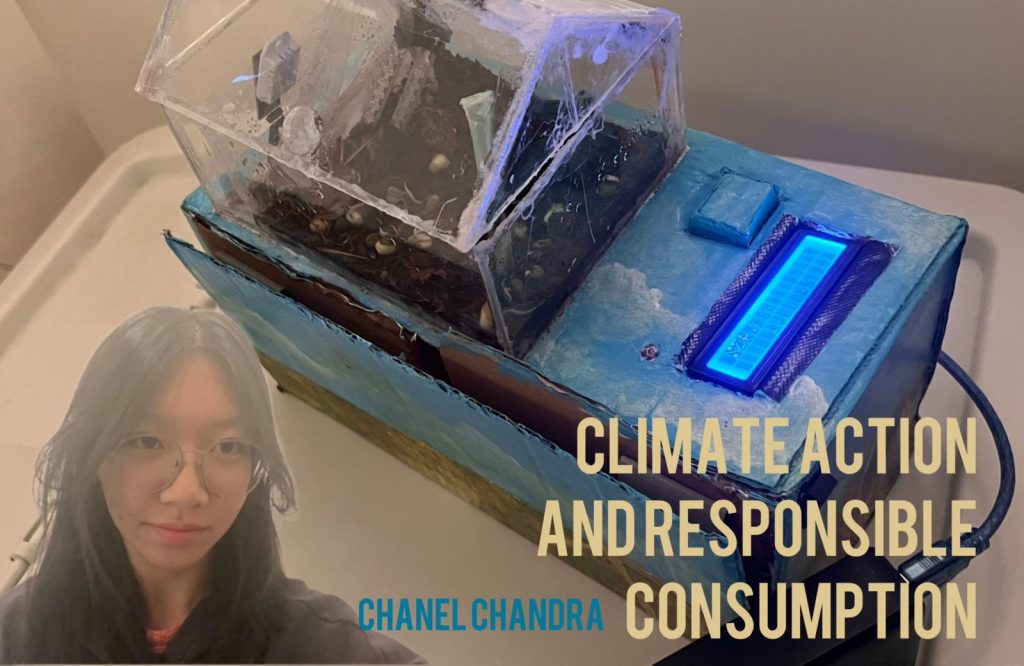
LiteHouse is an innovative, self-sustaining plant system designed to tackle food insecurity in urban areas, where land for farming is becoming increasingly scarce due to rapid population growth. Built within an acrylic house structure that acts as the pot itself, LiteHouse allows people to grow food in small spaces by integrating automation, smart sensors, and efficient energy use to maintain an ideal environment for plant growth.
One of LiteHouse’s key innovations is its automated watering system, which uses a moisture soil sensor to detect dryness. When the soil becomes too dry, a DC water pump and motor activate a sprinkler system to provide the necessary water. In addition to water control, LiteHouse also manages light and climate conditions. A DHT22 sensor tracks temperature and humidity, while a light sensor measures light exposure. An RGB LED indicates light levels by changing color, and UV lights automatically turn on every six hours to support plant nutrition when necessary.
To ensure efficiency,iteHouse uses a Real-Time Clock (RTC), allowing it to make time-based decisions, such as checking soil moisture every three hours or adjusting light exposure. Users can manually activate the sprinkler using an IR sensor button, while an LCD display provides real-time updates on temperature, humidity, and watering status. The system is powered by a rechargeable power bank for the Arduino and a 9V battery for the pump and motor, making it energy-efficient and adaptable to different urban settings.
Designed with tauge (bean sprouts) as an example, LiteHouse provides a sustainable and accessible way for urban residents to grow their own food, reducing reliance on store-bought produce and minimizing food waste. By integrating technology with urban farming, LiteHouse promotes responsible consumption, sustainable food production, and climate-conscious living, making it a practical solution for the future of urban agriculture
Air Pollution Adventure
Hello! We are from Group Trio Tanah Air and this is the description of the game we made
Rescue by Cleanliness
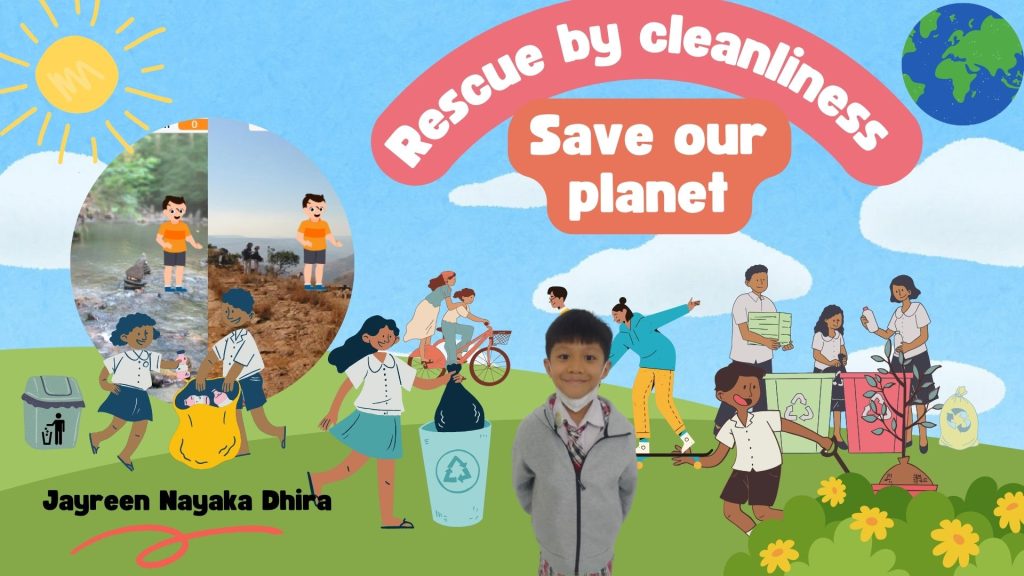
RESCUE BY CLEANLINESS
Nowadays people don’t care about the environment and there are so many people littering trash in cities and oceans not only those places because I always find trash in the ground. Because of that, I thought of an idea for the game and my idea was about cleaning trash in either the land or the ocean.
Rescue by Cleanliness is an immersive environmental game where players take on the role of a wildlife protector tasked with cleaning up polluted habitats to save endangered animals. As you journey through diverse ecosystems—beaches, oceans, cities, and more—you’ll encounter pollution harming wildlife, examples are plastic and trash.
Your mission is to clear these dangers by collecting trash and plastic within a limited time. With every piece of trash you collect you get 1 point. On the first level, you would require 15-20 points, once you do have 15-20 points you would just need to wait for it to switch levels. In level two you get a new challenge to collect more trash with a differeunt of time, you would require 25-35 points to go to the final level. On the final level, you could collect points freely and try your best to get lots of points and even though you don’t get a lot of points you still win because you tried to save planet Earth
Let’s g0rganic!
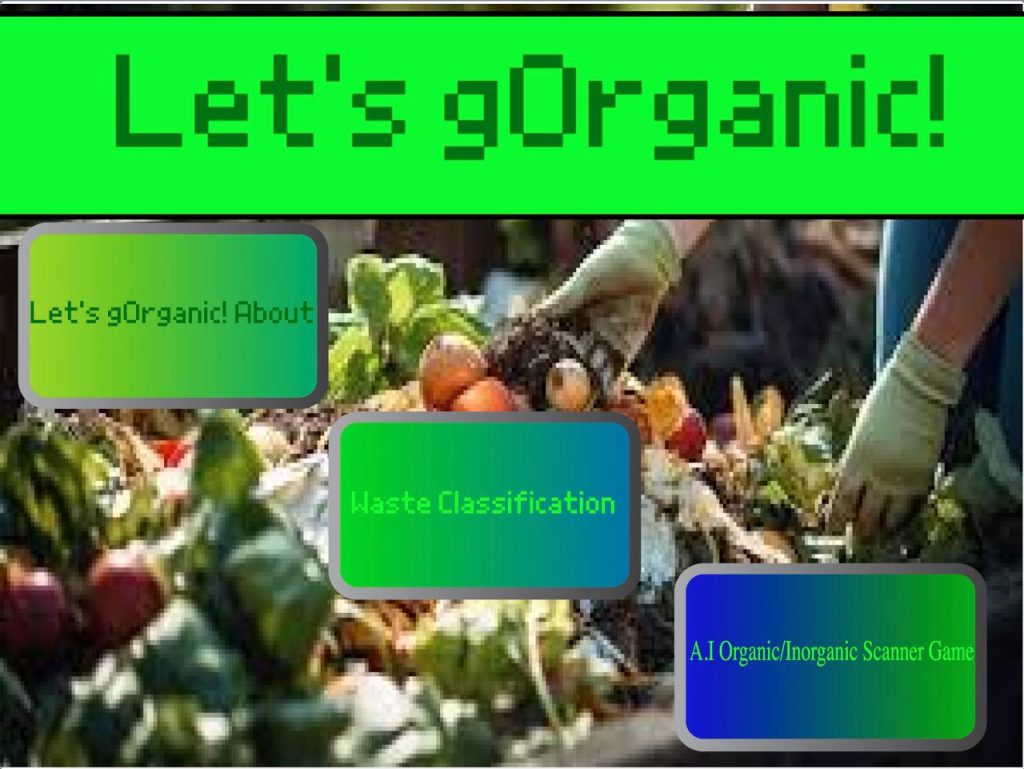
Hello, my name is Chise and i’m 11. I come from Bukit Sunrise School and i’m in grade 5. I also come from the coding school of KodeKiddo My project’s name is Let’s gOrganic and it is an app designed to help children learn about trash types that are organic and inorganic. Its theme is Climate Action and Responsible Consumption. My team is solo but I had help from my mentor to code the AI game. It also has an AI scanner game that identifies if the item is organic or inorganic. It also has a waste classification app that give you a short description of organic and inorganic waste. I used a machine learning AI that classifies images by giving it samples for different classes and you train it so that the AI can recognize if it is inorganic or organic. The way I got is idea is because of the limited amount of education for differentiating trash types and I felt inspired to make something for this years Codeavour to teach children about differentiating trash types. This took me only like 1 and a half weeks with dedication and education. I decided to join because I wanted to try something new and learn something new! Thank you for your time and patience and thank you for reading it too!
Saving Earth From Polution
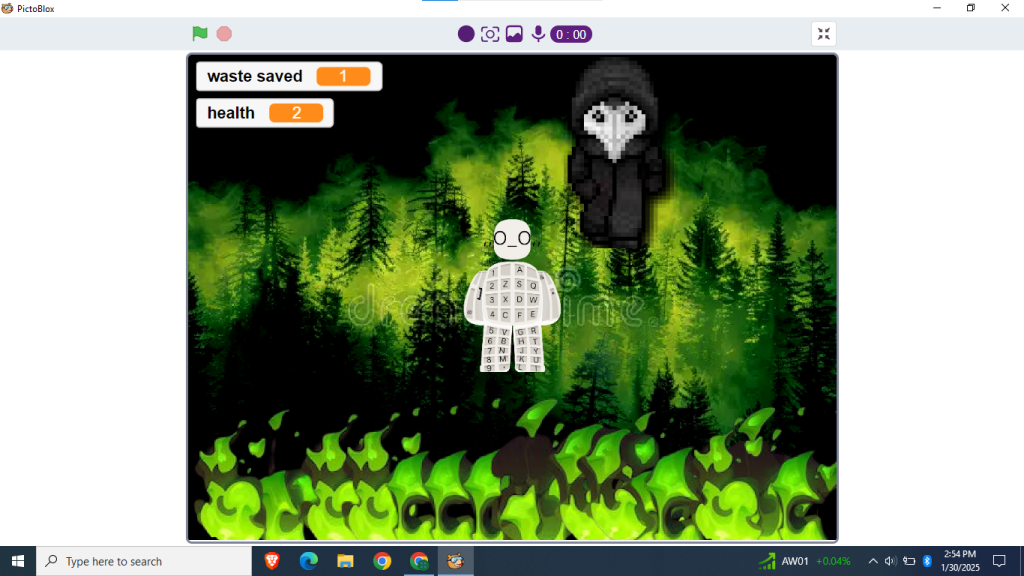
Hello My Name is Kevin Kenzo I will explain my project in pictoblox
So there is a plague doctor he is your enemy and you have to defeat him there is three stages in this game
In stage one is easy but the stage two i make it a lot harder and the stage three is the hardest
So you fight him and shoot him with an injection
There is no reloading in this game so you can freely shoot him
You shoot by pressing space button
He also will spawn a lot of toxic waste or barrel of toxic
In the second stage he will spawn more waste while dodging his attack
And in the stage three he will spawn some of his crews
The crews will try to kill you
So you need to be careful
There is also some green fire in the bottom of the map
The toxic waste makes pollution So you have to stop the plague and
Shoot all of the barrel of toxic
You control the game with your index finger
It use finger detection so its detect the top of your index finger
You only have 6 life And the waste saved or the barrel you shot
Give you score but the score in this game written as waste saved
Trash Sorter
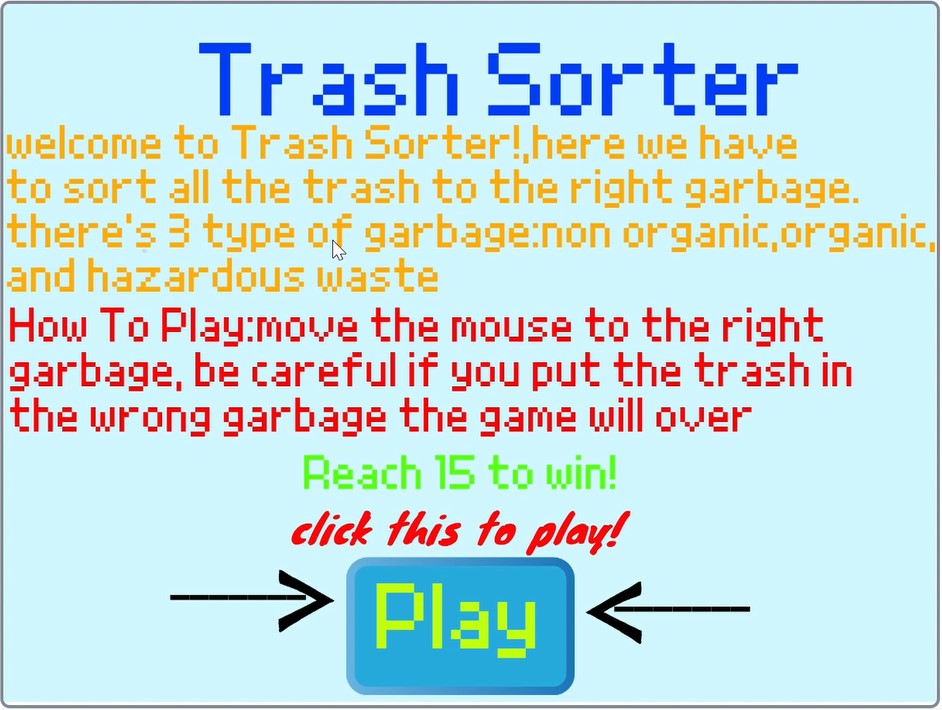
Many people in indonesia do not know how to properly sort their waste into recyclables, compostable, and trash. This can lead to items being placed in the wrong bins and that could caused Improper sorting can increase the costs of waste management, cause delays in the recycling process, and result in more waste being sent to landfills.
Trash Sorter is a game where you have to sort all of the trash, there’s type of trash, non organic, organic, and hazardous waste. Non organic waste is a type of waste that does not contain organic compounds. Organic waste is any material that is biodegradable and comes from either a plant or an animal. Hazardous waste is a waste with properties that make it dangerous or capable of having a harmful effect on human health or the environment.
This game teaches Kids about the environment early (Ensure that instructions about what goes into which bin are clear and easy to understand. This could include color-coded bins and simple visuals to indicate what types of waste should bplaced where), helps kid think smarter, and give kids instant rewards, like points or stars, for getting things right. This keeps them motivated and excited to keep playing and learning.
Plastic Waste
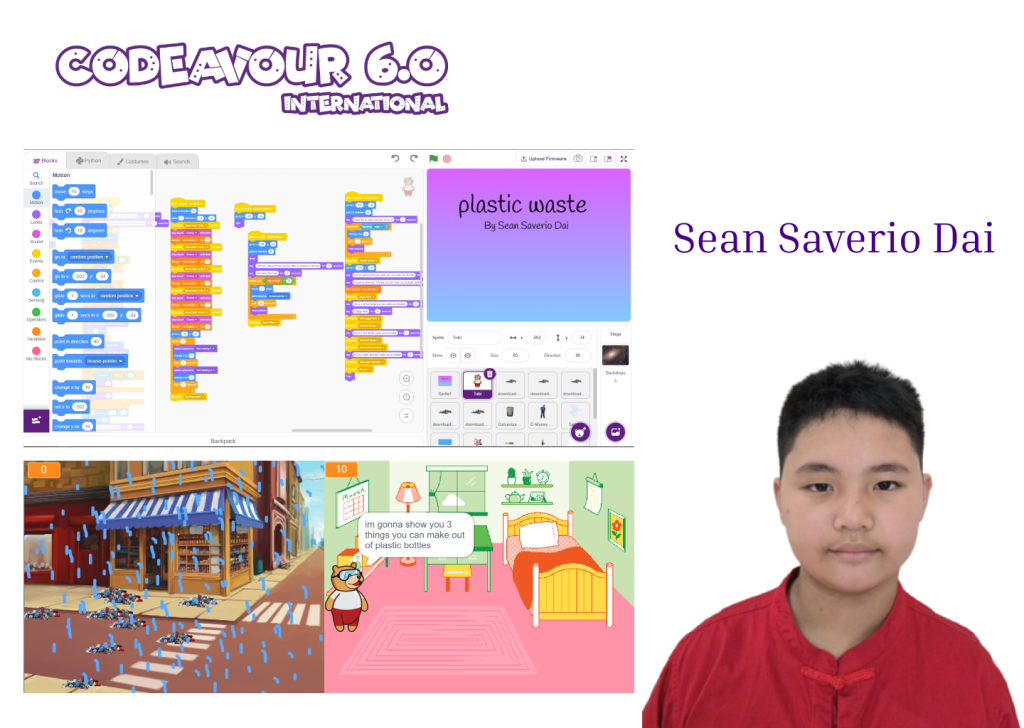
Hello, today I will be describing my Codeavour project, created by Sean Saverio Dai. This project focuses on trash and recycling, aiming to raise awareness about littering and teach kids how to repurpose waste materials. By making recycling fun, the project encourages children to think critically about their environmental impact. The game is highly interactive and includes tasks like picking up trash, where kids can track their scores as they progress through different challenges. Each task reinforces the importance of keeping our surroundings clean.
Younger children can also learn what they can make from plastic, such as a piggy bank or a pencil holder. This helps them see how everyday items can be repurposed, reducing waste and promoting creativity. The project is designed for children ages 5 and up, making it accessible for younger learners while still engaging for older kids. My goal is for kids to have fun while learning important lessons about recycling and reusing materials.
In the future, I plan to add more activities and challenges to the game to expand its educational impact. This will provide even more opportunities for kids to develop good environmental habits and understand the importance of sustainability. Overall, I hope this project encourages a new generation to be more mindful of their actions and the planet’s future.
Flappy Climate
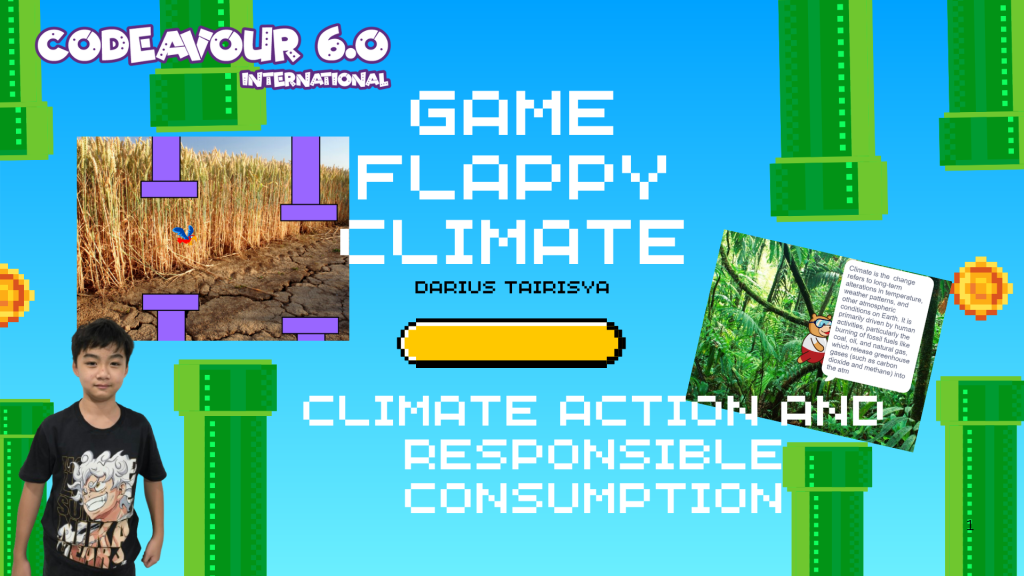
Flappy Climate is an interactive game developed using PictoBlox, inspired by the popular Flappy Bird. However, instead of just being an endless flying challenge, this game incorporates an educational twist to promote awareness of Climate Action and Responsible Consumption. Players control a flying character that must navigate through obstacles while witnessing the impact of environmental choices on the game’s background.
The core mechanics are simple yet engaging: players press a key or click the mouse to make the character flap and stay in the air while avoiding obstacles. For every certain number of points reached, the background image changes, representing different environmental conditions. The transitions showcase the effects of human actions on the climate, from lush green landscapes to polluted cities, melting ice caps, or barren lands caused by deforestation.
The game aligns with the Climate Action theme by visually representing the impact of carbon emissions, deforestation, and global warming. As pyers progress, they are subtly introduced to these environmental changes, reinforcing the urgency of taking action. Additionally, Responsible Consumption is highlighted by featuring images of sustainable practices, such as recycling, renewable energy use, and conservation efforts.
Flappy Climate is designed to be both entertaining and educational. By associating game progression with environmental transformation, players gain a deeper understanding of their role in climate preservation. The game encourages young minds to adopt sustainable habits and become more conscious of their consumption choices.
This project is a creative way to merge gaming with environmental education, making climate awareness accessible and engaging for all ages.
Trash Dodger
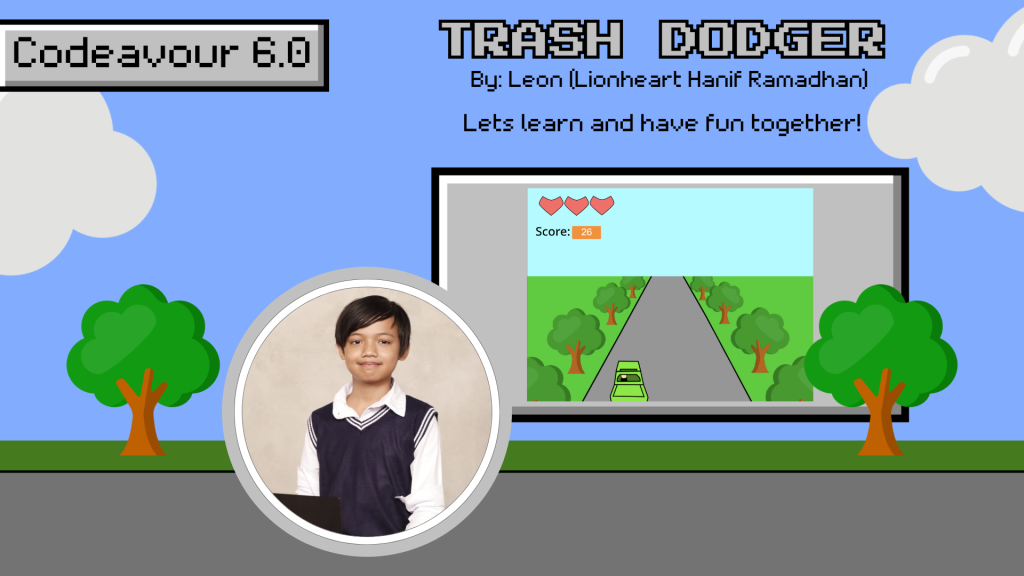
This game is an interactive experience where players control a car, navigating roads filled with scattered trash. The goal is simple: avoid obstacles and earn points by dodging them. Players must reach a target score to complete the game, making each move crucial for success.
The game consists of two levels: a tutorial and the main challenge. The tutorial introduces players to basic controls and mechanics, ensuring they understand how to steer and avoid trash. In Level 1, the real challenge begins as trash appears on the road, requiring precise movements to dodge them efficiently.
For every piece of trash successfully avoided, the player gains points. Once they reach the required score, they win the game. However, a star rating system evaluates their performance based on the number of lives remaining. Taking fewer hits results in a higher star rating, encouraging careful and strategic driving.
Throughout the gameplay, eco-friendly life advice appears, providing players with real-world sustainability tips, such as reducing waste, recycling, and making responsible choices. These messages reinforce the game’s theme while keeping players engaged.
With its simple yet engaging mechanics, this game offers an enjoyable experience for all ages. The challenge of dodging trash while aiming for the highest star rating keeps players motivated, while the sustainability messages add an educational aspect. By blending entertainment with awareness, the game delivers a fun way to promote eco-friendly habit
